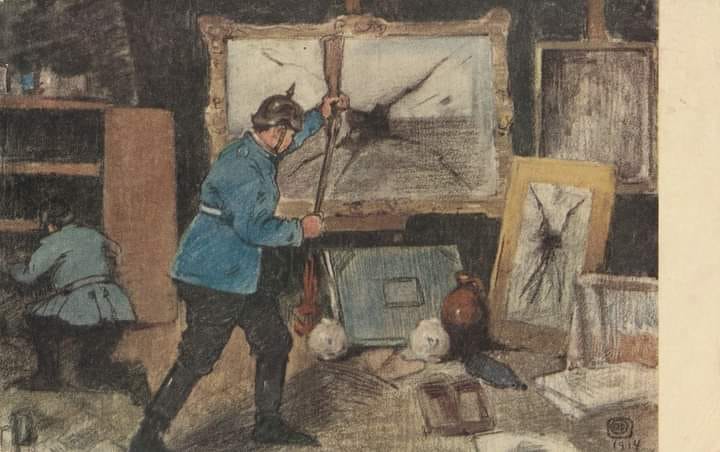Bob Teevan
The Sound of Breaking Glass

This card was published by The Sackville Gallery, London for L’oeuvre du Vêtement des soldats belges, (The Work for Belgian Soldier’s Clothing). It was never used. It is therefore a charity card seeking to raise funds for the benefit of the Belgian Army.
The card is entitled Kultur. The title is likely a swipe at the German soldiers (complete with pickelhaubes) destroying an artist’s studio. The obvious question is why the soldiers would destroy an art studio that was an unlikely threat to their safety. The answer is that invading forces are frequently destructive, and fear and intimidation are weapons in their arsenal.
Such destruction was not limited to German troops or restricted to the period of World War One. Throughout the centuries armies of almost every invader destroyed and looted as it moved. I suppose it is like a mountaineer who must climb mountains because “it is there;” invaders destroy property because “they can.”
The reverse of the card has added bits of information regarding the illustration. It is dated 1914 and there is a subtitle which reads ‘‘What they did in my Studio at Lierre” by Is. Opsomer. These bits suggests that the image we see is the destruction by German soldiers of the artist’s own studio and it is the pent-up anger and resentment of the artist which makes this illustration so good.
The artist Isidore Opsomer was born in Lierre in Belgium in 1878 and was a realistic and post-impressionist painter of portraits, cityscapes, landscapes and still life. He was also active as an etcher and a lithographer. He graduated from the Royal Academy of Fine Arts of Antwerp after only three years of study and broke into the art world with notoriety as early as 1901. He was an artist of some renown in the years prior to 1914 and juggled his artistic work with teaching at the Academy.
Opsomer travelled throughout Europe although lived and worked in Lierre which is some 18 miles southeast of Antwerp. In his correspondence, writer Frans Verschoren describes how the painter flees from Lierre in 1914.
“Opsomer told how he got out of Lierre at the very last moment. He served as a vigilante. The inhabitants had fled, yet a few other vigilantes had remained at their posts until Friday morning, although the bombs were raining steadily from all sides. That morning the situation was determined to be unbearable. Opsomer also decided to leave the city but went home to make some final arrangements.
“His home was located in the neighborhood of the Saint Gummarus church [a favorite German bomb-target]. When he left his house, there was not a mortal to be seen in the streets. He ran to the market and as he crossed the Nethebrug he heard shrapnel whistling and suddenly felt that his legs were failing. He sat down on a bridge bewildered and with the impression that he was done for. He soon recovered from his emotions and rushed on to safety.
“The painter traveled with his wife and child to Ostend where, in the nick of time, they board the last mail boat to Dover. They end up in the village of Beaconsfield, where they find safety in a villa with a garden.
The quiet life in Beaconsfield was not a good fit for the Opsomers. In March 1915, the family moved to London. At the suggestion of Minister Poullet, Opsomer eventually leaves for the Netherlands to organize exhibitions on behalf of the Belgian government. He settles in The Hague, while his wife returns to Lierre with their son. Upon his return to his studio in Lierre, he finds it in ruins. He therefore settled in Antwerp and became a teacher at the National Higher Institute of Fine Arts.”
The illustration on the postcard is dated 1914. It is uncertain as to whether this relates to the event pictured or the date of the artwork. The suggestion is that Opsomer discovered the destruction of his studio after 1914 when returning to Lierre. This may mean that the illustration was done after 1914. That said, Opsomer didn’t witness the above event and the image was drawn from his imagination of the event.
Only one other copy of this card has been seen. It was also unused and therefore difficult to date. The inclusion of the date “1914” and the name of the beneficiaries of the charity from the sale of the card are enough evidence to state that the card was published during the war.
In this case, I wouldn’t be surprised if they laid havoc because the owner of the studio was a Jew.
I wish I could somehow see the Opsomer works that were lost to history through senseless destruction.
Interesting but sad. I wish I could see more of Opsomer’s art. Wondering how Bob found all that info ?
Wow! Over and over again, this magazine and it’s contributors deliver the goods!